Zooplankton
| Part of a series on |
| Plankton |
|---|
 |
Zooplankton are the animal (or heterotrophic) component of the
Zooplankton can be contrasted with
Many
.The distinction between autotrophy and heterotrophy often breaks down in very small organisms. Recent studies of marine microplankton have indicated over half of microscopic plankton are mixotrophs. A mixotroph is an organism that can behave sometimes as though it were a plant and sometimes as though it were an animal, using a mix of autotrophy and heterotrophy. Many marine microzooplankton are mixotrophic, which means they could also be classified as phytoplankton.
Overview
Zooplankton (
Zooplankton is a categorization spanning a range of
Just as any species can be limited within a geographical region, so are zooplankton. However, species of zooplankton are not dispersed uniformly or randomly within a region of the ocean. As with phytoplankton, 'patches' of zooplankton species exist throughout the ocean. Though few physical barriers exist above the
Through their consumption and processing of phytoplankton and other food sources, zooplankton play a role in aquatic food webs, as a resource for consumers on higher trophic levels (including fish), and as a conduit for packaging the organic material in the biological pump. Since they are typically small, zooplankton can respond rapidly to increases in phytoplankton abundance,[clarification needed] for instance, during the spring bloom. Zooplankton are also a key link in the biomagnification of pollutants such as mercury.[6]
- Typical models featuring zooplankton
Zooplankton can also act as a
Size classification
Body size has been defined as a "master trait" for plankton as it is a morphological characteristic shared by organisms across taxonomy that characterises the functions performed by organisms in ecosystems.[9][10] It has a paramount effect on growth, reproduction, feeding strategies and mortality.[11] One of the oldest manifestations of the biogeography of traits was proposed over 170 years ago, namely Bergmann's rule, in which field observations showed that larger species tend to be found at higher, colder latitudes.[12][13]
In the oceans, size is critical in determining
The processes underlying the inverse relationship between body size and temperature remain to be identified.[17] Despite temperature playing a major role in shaping latitudinal variations in organism size, these patterns may also rely on complex interactions between physical, chemical and biological factors. For instance, oxygen supply plays a central role in determining the magnitude of ectothermic temperature-size responses, but it is hard to disentangle the relative effects of oxygen and temperature from field data because these two variables are often strongly inter-related in the surface ocean.[20][21][13]
Zooplankton can be broken down into size classes[22] which are diverse in their morphology, diet, feeding strategies, etc. both within classes and between classes:
| type of zooplankton | size range |
|---|---|
| picozooplankton | 2μm |
| nanozooplankton | 2-20μm |
| microzooplankton | 20-200μm |
| mesozooplankton | 0.2-20 millimeters |
Microzooplankton
Microzooplankton are defined as heterotrophic and
Despite their ecological importance, microzooplankton remain understudied. Routine oceanographic observations seldom monitor microzooplankton biomass or herbivory rate, although the dilution technique, an elegant method of measuring microzooplankton herbivory rate, has been developed for almost four decades (Landry and Hassett 1982). The number of observations of microzooplankton herbivory rate is around 1600 globally,[27][28] far less than that of primary productivity (> 50,000).[29] This makes validating and optimizing the grazing function of microzooplankton difficult in ocean ecosystem models.[26]
Mesozooplankton
Because plankton are rarely fished, it has been argued that mesoplankton abundance and
Taxonomic groups
Protozoans
Marine protozoans include
Radiolarians
-
Like diatoms, radiolarians come in many shapes
-
Also like diatoms, radiolarian shells are usually made of silicate
-
Howeveracantharian radiolarians have shells made from strontium sulfatecrystals
-
Cutaway schematic diagram of a spherical radiolarian shell
| External videos | |
|---|---|
Foraminiferans
Like radiolarians, foraminiferans (forams for short) are single-celled predatory protists, also protected with shells that have holes in them. Their name comes from the Latin for "hole bearers". Their shells, often called tests, are chambered (forams add more chambers as they grow). The shells are usually made of calcite, but are sometimes made of agglutinated sediment particles or chiton, and (rarely) silica. Most forams are benthic, but about 40 species are planktic.[36] They are widely researched with well-established fossil records which allow scientists to infer a lot about past environments and climates.[35]
-
section showing chambers of a spiral foram
-
Live Ammonia tepida streaming granular ectoplasm for catching food
-
Group of planktonic forams
-
TheEgyptian pyramids were constructed from limestone that contained nummulites.[37]
| External videos | |
|---|---|
Amoeba
-
Naked amoeba sketch showing food vacuoles and ingested diatom
-
Shell or test of atestate amoeba, Arcellasp.
-
Xenogenic testate amoeba covered in diatoms
Ciliates
-
Holophyra ovum
-
This ciliate is digesting cyanobacteria. The mouth is at the bottom right.
Dinoflagellates
Dinoflagellates are a phylum of unicellular flagellates with about 2,000 marine species.[38] Some dinoflagellates are predatory, and thus belong to the zooplankton community. Their name comes from the Greek "dinos" meaning whirling and the Latin "flagellum" meaning a whip or lash. This refers to the two whip-like attachments (flagella) used for forward movement. Most dinoflagellates are protected with red-brown, cellulose armour. Excavates may be the most basal flagellate lineage.[39]
-
Gyrodinium, one of the few naked dinoflagellates which lack armour
-
The dinoflagellate Protoperidinium extrudes a large feeding veil to capture prey
-
Nassellarianradiolarians can be in symbiosis with dinoflagellates
Dinoflagellates often live in
-
Tripos muelleri is recognisable by its U-shaped horns
-
velvet disease in fish[43]
-
Karenia brevis produces red tides highly toxic to humans[44]
-
Red tide
Mixotrophs
A
The distinction between plants and animals often breaks down in very small organisms. Possible combinations are photo- and chemotrophy, litho- and organotrophy, auto- and heterotrophy or other combinations of these. Mixotrophs can be either eukaryotic or prokaryotic.[47] They can take advantage of different environmental conditions.[48]
Many marine microzooplankton are mixotrophic, which means they could also be classified as phytoplankton. Recent studies of marine microzooplankton found 30–45% of the ciliate abundance was mixotrophic, and up to 65% of the amoeboid, foram and radiolarian biomass was mixotrophic.[49]
Mixotrophic zooplankton that combine phototrophy and heterotrophy – table based on Stoecker et al., 2017 [50]
| ||||||
|---|---|---|---|---|---|---|
| Description | Example | Further examples | ||||
| Called nonconstitutive mixotrophs by Mitra et al., 2016.[51] Zooplankton that are photosynthetic: microzooplankton or metazoan zooplankton that acquire phototrophy through chloroplast retentiona or maintenance of algal endosymbionts. | ||||||
| Generalists | Protists that retain chloroplasts and rarely other organelles from many algal taxa | 
|
Most oligotrich ciliates that retain plastidsa | |||
| Specialists | 1. Protists that retain chloroplasts and sometimes other organelles from one algal species or very closely related algal species | 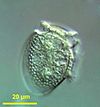
|
Dinophysis acuminata | Myrionecta rubra
| ||
| 2. Protists or zooplankton with algal endosymbionts of only one algal species or very closely related algal species | 
|
Noctiluca scintillans | ||||
| aChloroplast (or plastid) retention = sequestration = enslavement. Some plastid-retaining species also retain other organelles and prey cytoplasm. | ||||||
Phaeocystis species are endosymbionts to acantharian radiolarians.[52][53] Phaeocystis is an important algal genus found as part of the marine phytoplankton around the world. It has a polymorphic life cycle, ranging from free-living cells to large colonies.[54] It has the ability to form floating colonies, where hundreds of cells are embedded in a gel matrix, which can increase massively in size during blooms.[55] As a result, Phaeocystis is an important contributor to the marine carbon[56] and sulfur cycles.[57]
- Mixoplankton
-
Tintinnid ciliate Favella
-
Euglena mutabilis, a photosynthetic flagellate
-
Zoochlorellae (green) living inside the ciliateStichotricha secunda
-
The dinoflagellate Dinophysis acuta
A number of forams are mixotrophic. These have unicellular algae as endosymbionts, from diverse lineages such as the green algae, red algae, golden algae, diatoms, and dinoflagellates.[36] Mixotrophic foraminifers are particularly common in nutrient-poor oceanic waters.[58] Some forams are kleptoplastic, retaining chloroplasts from ingested algae to conduct photosynthesis.[59]
By trophic orientation, dinoflagellates are all over the place. Some dinoflagellates are known to be
Metazoa (animals)
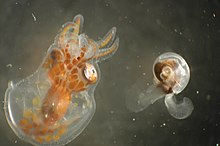
Free-living species in the crustacean class Copepoda are typically 1 to 2 mm long with teardrop-shaped bodies. Like all crustaceans, their bodies are divided into three sections: head, thorax, and abdomen, with two pairs of antennae; the first pair is often long and prominent. They have a tough exoskeleton made of calcium carbonate and usually have a single red eye in the centre of their transparent head.[61] About 13,000 species of copepods are known, of which about 10,200 are marine.[62][63] They are usually among the more dominant members of the zooplankton.[64]
In addition to copepods the crustacean classes ostracods, branchiopods and malacostracans also have planktonic members. Barnacles are planktonic only during the larval stage.[65]
- Metazoanzooplankton
-
Copepod with eggs
-
Segmented worm
-
Amphipod
Holoplankton and meroplankton
Ichthyoplankton
-
Juvenile planktonic squid
-
Ocean sunfish larvae (2.7mm)
-
Boxfishlarva
Gelatinous zooplankton
That view has recently been challenged. Jellyfish, and more gelatinous zooplankton in general, which include
-
This free-floatingbioluminescenttunicates
-
Salp chain
The importance of the so-called "jelly web" is only beginning to be understood, but it seems medusae, ctenophores and siphonophores can be key predators in deep pelagic food webs with ecological impacts similar to predator fish and squid. Traditionally gelatinous predators were thought ineffectual providers of marine trophic pathways, but they appear to have substantial and integral roles in deep
Role in food webs
Grazing by single-celled zooplankton accounts for the majority of
Grazing is a central, rate-setting process in ocean ecosystems and a driver of
- Pelagic food web
-
euphotic zone, while the darker blue waters represent the twilight zone.[80]

Role in biogeochemistry
In addition to linking primary producers to higher
Sloppy feeding and release of DOM
Excretion and sloppy feeding (the physical breakdown of food source) make up 80% and 20% of crustacean zooplankton-mediated DOM release respectively.[83] In the same study, fecal pellet leaching was found to be an insignificant contributor. For protozoan grazers, DOM is released primarily through excretion and egestion and gelatinous zooplankton can also release DOM through the production of mucus. Leaching of fecal pellets can extend from hours to days after initial egestion and its effects can vary depending on food concentration and quality.[84][85] Various factors can affect how much DOM is released from zooplankton individuals or populations. Absorption efficiency (AE) is the proportion of food absorbed by plankton that determines how available the consumed organic materials are in meeting the required physiological demands.[76] Depending on the feeding rate and prey composition, variations in AE may lead to variations in fecal pellet production, and thus regulates how much organic material is recycled back to the marine environment. Low feeding rates typically lead to high AE and small, dense pellets, while high feeding rates typically lead to low AE and larger pellets with more organic content. Another contributing factor to DOM release is respiration rate. Physical factors such as oxygen availability, pH, and light conditions may affect overall oxygen consumption and how much carbon is loss from zooplankton in the form of respired CO2. The relative sizes of zooplankton and prey also mediate how much carbon is released via sloppy feeding. Smaller prey are ingested whole, whereas larger prey may be fed on more “sloppily”, that is more biomatter is released through inefficient consumption.[86][87] There is also evidence that diet composition can impact nutrient release, with carnivorous diets releasing more dissolved organic carbon (DOC) and ammonium than omnivorous diets.[84]
High nutrient, low chlorophyll
Carbon export
Zooplankton play a critical role in supporting the ocean's
See also
- Census of Marine Zooplankton
- Diel vertical migration
- Ocean acidification
- Primary production
- Thin layers (oceanography)
References
- ISBN 978-0-226-26534-6.
- ^ "zooplankton". Lexico UK English Dictionary. Oxford University Press. Archived from the original on March 1, 2020.
- ^ "zooplankton". Merriam-Webster.com Dictionary.
- ISBN 978-0-13-262072-7.
- ^ ISBN 978-0-7506-3384-0.
- ^ "How We Do Things at IISD-ELA: Researching Mercury". IISD. 2017-04-05. Retrieved 2020-07-06.
- doi:10.3389/fmars.2017.00077..
 Material was copied from this source, which is available under a Creative Commons Attribution 4.0 International License
Material was copied from this source, which is available under a Creative Commons Attribution 4.0 International License - ^
Jude, B.A.; Kirn, T.J.; Taylor R.K. (2005). "A colonization factor links Vibrio cholerae environmental survival and human infection". S2CID 1964530.
- .
- S2CID 15891709.
- PMID 26163011.
- ^ Bergmann, Carl (1847). "Über die Verhältnisse der Wärmeökonomie der Thiere zu ihrer Grösse". Göttinger Studien. 3 (1): 595–708.
- ^ PMID 34344925..
 Material was copied from this source, which is available under a Creative Commons Attribution 4.0 International License
Material was copied from this source, which is available under a Creative Commons Attribution 4.0 International License - PMID 29295998.
- doi:10.1890/03-9000.
- PMID 21470708.
- ^ PMID 21676736.
- ISBN 9780120139255.
- PMID 21238056.
- S2CID 206562917.
- S2CID 92601781.
- PMID 27814033.
- S2CID 85568208.
- S2CID 22995996.
- ^ .
- ^ S2CID 224916151..
 Material was copied from this source, which is available under a Creative Commons Attribution 4.0 International License
Material was copied from this source, which is available under a Creative Commons Attribution 4.0 International License - .
- .
- S2CID 140628035.
- ISSN 0924-7963.
- ISBN 9780816067367.
- ISBN 9789401791182.
- ISBN 9780321649638.
- PMID 21413323. Retrieved 2018-03-23.
- ^ a b Wassilieff, Maggy (2006) "Plankton - Animal plankton", Te Ara - the Encyclopedia of New Zealand. Accessed: 2 November 2019.
- ^ ISBN 978-3-540-96815-3.
- ^ Foraminifera: History of Study, University College London. Retrieved: 18 November 2019.
- .
- PMID 23312067.
- ISBN 9783319281476.
- ^ Anderson, O. R. (1983). Radiolaria. Springer Science & Business Media.
- PMID 8896371.
- The Merck Veterinary Manual. Archived from the originalon 3 March 2016. Retrieved 4 November 2019.
- PMID 36733478.
- ^ Collins, Richard (2016-11-14). "Beware the mixotrophs - they can destroy entire ecosystems 'in a matter of hours'". Irish Examiner.
- ^ University, Swansea. "Microscopic body snatchers infest our oceans". phys.org.
- PMID 17028233.
- S2CID 22837754.
- PMID 28768886.
- ^ S2CID 25579538. Archived from the original(PDF) on 2019-02-27.
- PMID 26927496.
- PMID 23071304.
- PMID 30210473.
- .
- ^ "Welcome to the Phaeocystis antarctica genome sequencing project homepage".
- S2CID 4409009.
- .
- ISBN 978-1-4684-7612-5.
- .
- S2CID 83885629.
- ISBN 978-0-03-056747-6.
- ^ "WoRMS - World Register of Marine Species - Copepoda". www.marinespecies.org. Archived from the original on 2019-06-30. Retrieved 2019-06-28.
- S2CID 31727589.
- Carl von Ossietzky University of Oldenburg. Archived from the originalon May 26, 2010. Retrieved December 8, 2009.
- ^ Treatise on Zoology - Anatomy, Taxonomy, Biology. The Crustacea
- ^ "What are Ichthyoplankton?". Southwest Fisheries Science Center. 2007-09-03. Archived from the original on 2018-02-18. Retrieved 2011-07-22.
- ISBN 9780520932470.
- ^ doi:10.1038/531432a
- ^
- ^ doi:10.1098/rspb.2017.2116..
 Material was copied from this source, which is available under a Creative Commons Attribution 4.0 International License
Material was copied from this source, which is available under a Creative Commons Attribution 4.0 International License - ^ doi:10.3389/fmars.2021.695938..
 Material was copied from this source, which is available under a Creative Commons Attribution 4.0 International License
Material was copied from this source, which is available under a Creative Commons Attribution 4.0 International License - ^ .
- ^ .
- S2CID 206560125.
- ^ PMID 27814033.
- .
- PMID 20462113.
- PMID 29335403.
- doi:10.3389/fmars.2016.00022..
 Material was copied from this source, which is available under a Creative Commons Attribution 4.0 International License
Material was copied from this source, which is available under a Creative Commons Attribution 4.0 International License - .
- .
- .
- ^ .
- ISBN 9780124071537.
- .
- .
- ^ S2CID 222003883..
 Material was copied from this source, which is available under a Creative Commons Attribution 4.0 International License
Material was copied from this source, which is available under a Creative Commons Attribution 4.0 International License - Bibcode:2019AGUFMPP42C..12D.
External links
- SAHFOS Sir Alister Hardy Foundation for Ocean Science
- Ocean Drifters Short film narrated by David Attenborough about the varied roles of plankton
- Sea Drifters BBC Audio slideshow
- Plankton Chronicles Short documentary films & photos
- COPEPOD: The global plankton database. A global coverage database of zooplankton biomass and abundance data.
- Guide to the marine zooplankton of south eastern Australia, Tasmanian Aquaculture and Fisheries Institute
- Australian Continuous Plankton Recorder Project Archived 2008-12-01 at the Wayback Machine
- An Image-Based Key to Zooplankton of North America

![Upper left: Biogeochemical models Right: Ecosystem models Lower left: Size-spectra models These models also have temporal and spatial components.[7]](http://upload.wikimedia.org/wikipedia/commons/e/ec/Typical_ocean_models_featuring_zooplankton_2.jpg)

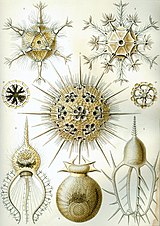
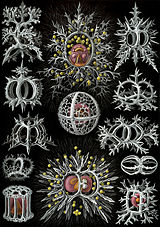
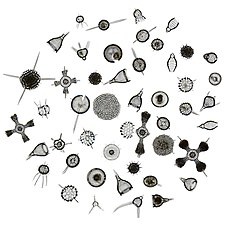


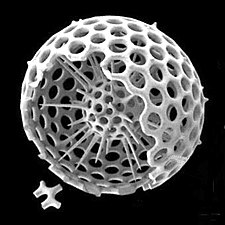
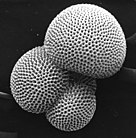
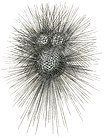

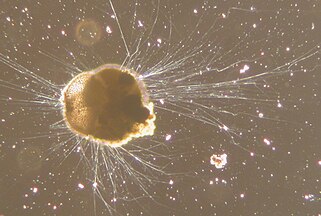
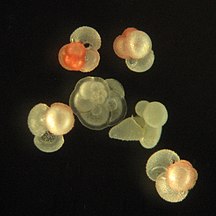
![The Egyptian pyramids were constructed from limestone that contained nummulites.[37]](http://upload.wikimedia.org/wikipedia/commons/thumb/a/af/All_Gizah_Pyramids.jpg/325px-All_Gizah_Pyramids.jpg)








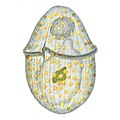




![Oodinium, a genus of parasitic dinoflagellates, causes velvet disease in fish[43]](http://upload.wikimedia.org/wikipedia/commons/thumb/8/87/Archives_de_zoologie_exp%C3%A9rimentale_et_g%C3%A9n%C3%A9rale_%281920%29_%2820299351186%29.jpg/260px-Archives_de_zoologie_exp%C3%A9rimentale_et_g%C3%A9n%C3%A9rale_%281920%29_%2820299351186%29.jpg)
![Karenia brevis produces red tides highly toxic to humans[44]](http://upload.wikimedia.org/wikipedia/commons/thumb/a/a0/Karenia_brevis.jpg/214px-Karenia_brevis.jpg)





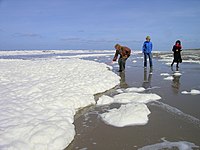

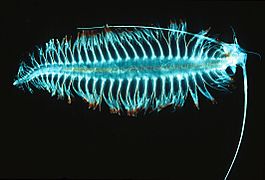
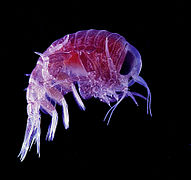


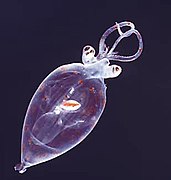
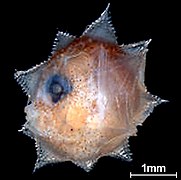


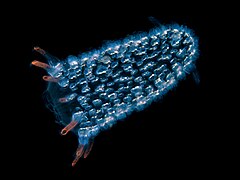

![Pelagic food web and the biological pump. Links among the ocean's biological pump and pelagic food web and the ability to sample these components remotely from ships, satellites, and autonomous vehicles. Light blue waters are the euphotic zone, while the darker blue waters represent the twilight zone.[80]](http://upload.wikimedia.org/wikipedia/commons/thumb/1/13/Export_Processes_in_the_Ocean_from_Remote_Sensing.jpg/627px-Export_Processes_in_the_Ocean_from_Remote_Sensing.jpg)



